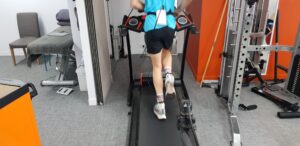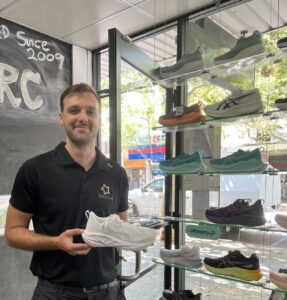Running Shoes and Injury.
Normal Running Loads.
It can be frustrating for a runner to be sidelined with an injury. Running places considerable stress on the muscles, joints, tendons and ligaments. Even the most efficient runners see loads of 2-3 times their body weight going through the lower limbs during running.
Running After Injury.
The effects of these stresses are more significant for runners who have had time off after an injury! The longer the hiatus from running, the less load the body can tolerate initially.
The key to a successful return to running is to allow the soft tissues time to adapt. We must reintroduce the stressing demands of running at an appropriate rate and volume. This is achieved through conditioning and strength training and proper periodisation of a return to run program. Running shoe choice may also have a significant impact. Star Physio’s expert team of physios and podiatrists can help you with this!
We have spoken at length in previous blogs about how crucial progressive load exposure and lower limb conditioning are to returning to running following injury here. Below we look at types of running shoes before outlining our top picks for post injury runners.
Finding the Right Shoe
The right pair of running shoes will help prevent further injuries and improve comfort. But the right shoes for one person will likely be different for another. Finding the right pair for you is about knowing what kind of runner you are and what’s comfortable for you.
To find the right shoes, you may need to consider the pronation and supination of your feet, which describe the natural movements of the foot. This is particularly important if you are injured or recovering from or susceptible to injury. Luckily, there are shoes to compensate for these movements, which combined with correct preparation and strength training, can significantly reduce the chance of injury. Interestingly when we look at shoes to prevent injuries, the research tells us that the best shoe for you is often the one that feels most comfortable!
At Star Physio we offer running analysis with the amazing Gebiomized Foot Pressure system that identifies subtle differences in ground contact time and pressure across the foot. This information helps our experts determine the best shoes, technique advice and potentially exercise program for you. Book your running analysis here!
Types of Running Shoes
There are three basic foot types and running shoes come in slightly different shapes to match them. A simple way to determine your foot type is to look at the impression you leave when your foot is wet. A better option is to have a gait analysis, which involves a trained individual observing how you move your feet.
Shoe types include:
- Cushioned – combines arch support and cushioning, designed for a runner with a neutral foot (do not excessively pronate or supinate)
- Stability – provides extra cushioning and shock absorption, designed for runners who over-supinate.
- Motion control – offers rigid arch support for people who over-pronate.
Research suggests neutral shoes work well for most people. Comfort, balance and fit are ultimately more important than the shoe type, especially when you’re trying to reduce stress after injury. It’s just a matter of trying lots of different shoes for the perfect fit.
Recommended Running Shoes Post Injury
There are many factors to look at when purchasing a new running shoe. If you have a long background in running, and a long list of previous injuries, you will likely be less adaptable to change so stick to what you know. Our best advice would be ‘wear what you’ve worn before!’. However, we often get the question of which specific running shoe is ‘best’, so we thought we’d offer some suggestions.
Below we list a variety of options with these factors in mind.
Dr Sam Steel’s pick of the Best Running Shoes Post Injury.
1. Brooks Adrenaline
Great running shoe for those who tend to over pronate (roll in) more or have had knee and ankle injuries. The Brooks Adrenaline boasts a “Guiderail Technology” which is designed to keep runners on their natural path, intending to reduce any excessive movements which can lead to re injury. The newest iteration of the Brooks Adrenaline also has a 12mm heel drop which can help to de load the calf and achilles tendon which can be great when recovering from injuries. Brooks are also a really good option for those who have wider feet, with a lot of wide options available making sure to not squish the toes providing greater comfort when running.
2. Asics Gel Kayano
One of the most popular running shoes for a long time and for good reason. The Gel Kayano is described as a stability-neutral shoe. The Gel Kayano provides great support for those who overpronate without over correcting the foot. It also offers great lateral stability as well, reducing tension on the tendons that run along the outside of your foot and ankle. Recent additions of the Gel Kayano have changed slightly. The 31 boasts a 2mm greater heel to toe drop in comparison to the 32 so may be more applicable for those returning from posterior injuries to the calf of achilles tendon.
3. Hoka Bondi
This shoe is a great option for those looking for slower runs. The Bondi has a bulkier feel in comparison to a lot of other shoes. Although this provides maximal cushioning and shock absorption, this shoe may limit responsiveness and might not be appropriate for those looking for shorter, faster runs. Famous for its rocker bottom geometry, the Bondi is a great shoe for reducing impact on the joints by promoting the foots natural rockers itself. This will be a great shoe for those recovering from plantar fasciitis, forefoot pain or those with osteoarthritis.
4. Asics Gel Nimbus
An Asics variation for those with a higher or more neutral arch. The Gel nimbus provides a great plush and cushioning feel for those with high arches who may need a bit more shock absorption when they run. It has a great wide base providing good stability upon heel strike. As a neutral shoe, this provides extra space for potential inserts or custom orthotics which may be a factor to consider if you have a pair of these.
5. Saucony Ride
This a great versatile shoe. Like the Gel Kayano, it is a good mix between cushioning and stability. While it may not offers as much support through out the arch as other shoes, it has a nice wide base to provide greater stability during gait. It is a good versatile shoe that can be used for a variety of different runs. The Saucony Ride provides great shock absorption and has been recommended as a great shoe for those recovering from shin splints.
6. Mizuno Wave Paradox 3
Mizuno work very hard on running shoe technology and have a huge band of loyal followers. Their shoes were the second most popular choice for athletes at the Busselton 100 in 2025. The Paradox is the one shoe that replaced both the Nirvana and the Alchemy. It is a step up in stability from the Inspire, offering a very stable ride with the signature responsive Mizuno feel.
As always, if you unsure of which running shoes you should be in, or are suffering from running injuries, make sure you drop in and see one of the experts at Star Physio to help you back to pain free running! Book here to see one of our expert running podiatrists!
What about recovery slides?
Recovery slides have become a great option in the last few years for those recovering from injury. Originally designed for athletes post work out, these shoes have found their way into the market for those recovering from both chronic and acute injuries to wear around home instead of their everyday shoes.
They often provide great arch support and a rocker bottom to take the stress off joints when walking. All the while being made of extremely comfortable and responsive materials to provide great comfort when walking around at home after your runs. Some of the recovery slides I like are the OOFOS OOahh Slide or the Hook Ora Slide.
Strength Training and Conditioning
Another effective way to minimise the risk injury and reduce strain is to strengthen the muscles involved in running. Our team at Star Physio in knows that tissue strength confers protection against injury beyond all else!!. In fact, you can reduce overuse injuries by almost 50% using conditioning and strength training techniques.
Understanding the right exercises, appropriate loads, sets and repetitions and how to fit them in to your exercise calendar is what the Star Physio experts do best!
Call 08 64249578 or book online for an appointment today.


